Effect of Cold Rolling on the Evolution of Shear Bands and Nanoindentation Hardness in Zr41.2Ti13.8Cu12.5Ni10Be22.5 Bulk Metallic Glass
Abstract
:1. Introduction
2. Experimental Procedure
3. Results
3.1. DSC Studies and Free Volume Estimation
3.2. Characterization of Shear Bands on the NR Plane
3.3. Nanoindentation Studies at Various Pmax (50 mN–500 mN)
3.4. Studies on the Indentation Impression under SEM
4. Discussion
4.1. Effect of Cold Rolling on Elastic-Plastic Response
4.2. Serrated to Smooth Flow on NR, RW, and NW Planes upon Cold Rolling
4.3. Effect of Cold Rolling on Structure, H and E
5. Conclusions
- The hardness at the specimen surface varied with cold rolling percentage (%) and the variation is similar on the RW and NR planes at all different peak loads in the range of 50 mN–500 mN, whereas the same is insignificant for the core region of the specimen on the NW plane. H and E values increase in CR4.5 and CR31, whereas CR10 and CR20 become softer than CR0 upon cold rolling on the RW and NR planes.
- 3D optical surface profilometry studies on the NR plane suggest that the shear band spacing decreases from 57.7 μm (CR4.5) to 24.6 μm (CR31), and the shear band offset height increases from 2.4 μm (CR4.5) to 4.4 μm (CR31) with the increase in the extent of cold rolling. Meanwhile, the number of pop-in events during nanoindentation for all the planes reduces with the increase in the extent of cold rolling, and the disappearance of shear bands around indentation impression points to more homogeneous deformation in cold rolled BMGs.
- The nanoindentation, DSC studies, and model calculations suggest that the annihilation rate dominated over the free volume creation rate, which produce a relaxed and dense glassy structure in CR4.5 and CR31, exhibiting enhanced H and E.
Supplementary Materials
Author Contributions
Funding
Data Availability Statement
Acknowledgments
Conflicts of Interest
References
- Suryanarayana, C.; Inoue, A. Bulk Metallic Glasses; CRC Press: New York, NY, USA, 2011. [Google Scholar]
- Kumar, G.; Neibecker, P.; Liu, Y.H.; Schroers, J. Critical fictive temperature for plasticity in metallic glasses. Nat. Commun. 2013, 4, 1536. [Google Scholar] [CrossRef] [PubMed] [Green Version]
- Egami, T. Formation and deformation of metallic glasses: Atomistic theory. Intermetallics 2006, 14, 882–887. [Google Scholar] [CrossRef]
- Sinning, H.R.; Leonardsson, L.; Cahn, R.W. Irreversible anisotropic length changes in fe40ni40b20 and a search for reversible length changes in several metallic glasses. Int. J. Rapid Solidif. 1985, 1, 175–197. [Google Scholar]
- Poulsen, H.F.; Wert, J.A.; Neuefeind, J.; Aki, V.H.; Daymond, M. Measuring strain distributions in amorphous materials. Nat. Mater. 2004, 4, 33–36. [Google Scholar] [CrossRef]
- Ott, R.T.; Kramer, M.J.; Besser, M.F.; Sordelet, D.J. High-energy X-ray measurements of structural anisotropy and excess free volume in a homogenously deformed Zr-based metallic glass. Acta Mater. 2006, 54, 2463–2471. [Google Scholar] [CrossRef]
- Dmowski, W.; Tong, Y.; Iwashita, T.; Yokoyama, Y.; Egami, T. Universal mechanism of thermomechanical deformation in metallic glasses. Phys. Rev. B 2015, 91, 60101. [Google Scholar] [CrossRef] [Green Version]
- Shahabi, H.S.; Scudino, S.; Kaban, I.; Stoica, M.; Rütt, U.; Kühn, U.; Eckert, J. Structural aspects of elasto-plastic deformation of a Zr-based bulk metallic glass under uniaxial compression. Acta Mater. 2015, 95, 30–36. [Google Scholar] [CrossRef]
- Revesz, A.; Schafler, E.; Kovacs, Z. Structural anisotropy in a Zr57Ti5Cu20Al10Ni8 bulk metallic glass deformed by high pressure torsion at room temperature. Appl. Phys. Lett. 2008, 92, 011910. [Google Scholar] [CrossRef]
- Dmowski, W.; Egami, T. Structural anisotropy in metallic glasses induced by mechanical deformation. Adv. Eng. Mater. 2008, 10, 1003–1007. [Google Scholar] [CrossRef]
- Spaepen, F. A microscopic mechanism for steady state inhomogeneous flow in metallic glasses. Acta Metall. 1977, 25, 407–415. [Google Scholar] [CrossRef]
- Heggen, M.; Spaepen, F.; Feuerbacher, M. Creation and annihilation of free volume during homogeneous flow of a metallic glass. J. Appl. Phys. 2005, 97, 1–8. [Google Scholar] [CrossRef] [Green Version]
- Schuh, C.A.; Hufnagel, T.C.; Ramamurty, U. Mechanical behavior of amorphous alloys. Acta Mater. 2007, 55, 4067–4109. [Google Scholar] [CrossRef]
- Argon, A.S. Plastic deformation in metallic glasses. Acta Metall. 1979, 27, 47–58. [Google Scholar] [CrossRef]
- Steif, P.S.; Spaepen, F.; Hutchinson, J.W. Strain localization in amorphous metals. Acta Metall. 1982, 30, 447–455. [Google Scholar] [CrossRef]
- van den Beukel, A.; Sietsma, J. The glass transition as a free volume related kinetic phenomenon. Acta Metall. Mater. 1990, 38, 383–389. [Google Scholar] [CrossRef]
- Schuh, C.A.; Lund, A.C. Atomistic basis for the plastic yield criterion of metallic glass. Nat. Mater. 2003, 2, 449–452. [Google Scholar] [CrossRef] [PubMed]
- Furukawa, A.; Tanaka, H. Inhomogeneous flow and fracture of glassy materials. Nat. Mater. 2009, 8, 601–609. [Google Scholar] [CrossRef]
- Spaepen, F. Must shear bands be hot? Nat. Mater. 2006, 8, 601–609. [Google Scholar] [CrossRef]
- de Hey, P.; Sietsma, J.; van den Beukel, A. Structural Disordering In Amorphous Pd40Ni40P20 Induced By High Temperature Deformation. Acta Mater. 1998, 46, 5873–5882. [Google Scholar] [CrossRef]
- Bei, H.; Xie, S.; George, E.P. Softening caused by profuse shear banding in a bulk metallic glass. Phys. Rev. Lett. 2006, 96, 105503. [Google Scholar] [CrossRef]
- Pan, J.; Chen, Q.; Liu, L.; Li, Y. Softening and dilatation in a single shear band. Acta Mater. 2011, 59, 5146–5158. [Google Scholar] [CrossRef]
- Jian, W.R.; Wang, L.; Yao, X.H.; Luo, S.N. Tensile and nanoindentation deformation of amorphous/crystalline nanolaminates: Effects of layer thickness and interface type. Comput. Mater. Sci. 2018, 154, 225–233. [Google Scholar] [CrossRef]
- Jian, W.R.; Wang, L.; Li, B.; Yao, X.H.; Luo, S.N. Improved ductility of Cu64Zr36 metallic glass/Cu nanocomposites via phase and grain boundaries. Nanotechnology 2016, 27, 175701. [Google Scholar] [CrossRef] [PubMed]
- Deng, C.; Schuh, C.A. Atomistic mechanisms of cyclic hardening in metallic glass. Appl. Phys. Lett. 2012, 100, 251909. [Google Scholar] [CrossRef]
- Zhao, D.; Zhu, B.; Wang, S.; Niu, Y.; Xu, L.; Zhao, H. Effects of pre-strain on the nanoindentation behaviors of metallic glass studied by molecular dynamics simulations. Comput. Mater. Sci. 2021, 186, 110073. [Google Scholar] [CrossRef]
- Das, J.; Tang, M.B.; Kim, K.B.; Theissmann, R.; Baier, F.; Wang, W.H.; Eckert, J. “Work-Hardenable” Ductile Bulk Metallic Glass. Phys. Rev. Lett. 2005, 94, 205501. [Google Scholar] [CrossRef] [Green Version]
- Kim, K.B.; Das, J.; Venkataraman, S.; Yi, S.; Eckert, J. Work hardening ability of ductile Ti45Cu40Ni7.5Zr5Sn2.5 and Cu47.5Zr47.5Al5 bulk metallic glasses. Appl. Phys. Lett. 2006, 89, 071908. [Google Scholar] [CrossRef]
- Lee, M.H.; Lee, K.S.; Das, J.; Thomas, J.; Kühn, U.; Eckert, J. Improved plasticity of bulk metallic glasses upon cold rolling. Scr. Mater. 2010, 62, 678–681. [Google Scholar] [CrossRef]
- Packard, C.E.; Witmer, L.M.; Schuh, C.A. Hardening of a metallic glass during cyclic loading in the elastic range. Appl. Phys. Lett. 2008, 92, 171911. [Google Scholar] [CrossRef] [Green Version]
- Wang, Z.T.; Pan, J.; Li, Y.; Schuh, C.A. Densification and strain hardening of a metallic glass under tension at room temperature. Phys. Rev. Lett. 2013, 111, 135504. [Google Scholar] [CrossRef]
- Oliver, W.C.; Pharr, G.M. An improved technique for determining hardness and elastic modulus using load and displacement sensing indentation experiments. J. Mater. Res. 1992, 7, 1564–1583. [Google Scholar] [CrossRef]
- Jana, P.P.; Gunti, A.; Das, J. Improvement of intrinsic plasticity and strength of Zr55Cu30Ni5Al10 metallic glass by tuning the glass transition temperature. Mater. Sci. Eng. A 2019, 762, 138102. [Google Scholar] [CrossRef]
- Slipenyuk, A.; Eckert, J. Correlation between enthalpy change and free volume reduction during structural relaxation of Zr55Cu30Al10Ni5metallic glass. Scr. Mater. 2004, 50, 39–44. [Google Scholar] [CrossRef]
- Flores, K.M.; Sherer, E.; Bharathula, A.; Chen, H.; Jean, Y.C. Sub-nanometer open volume regions in a bulk metallic glass investigated by positron annihilation. Acta Mater. 2007, 55, 3403–3411. [Google Scholar] [CrossRef]
- Launey, M.E.; Kruzic, J.J.; Li, C.; Busch, R. Quantification of free volume differences in a Zr44Ti11Ni10Cu10Be25 bulk amorphous alloy. Appl. Phys. Lett. 2007, 91, 051913. [Google Scholar] [CrossRef]
- Masuhr, A.; Busch, R.; Johnson, W.L. Thermodynamics and Kinetics of the Zr41.2Ti13.8 Cu10Ni12.5Be22.5 Bulk Metallic Glass Forming Liquid: Glass Formation from a Strong Liquid. J. Non Cryst. Solids. 1999, 250–252, 566–571. [Google Scholar] [CrossRef]
- Cao, Q.P.; Li, J.F.; Zhou, Y.H.; Jiang, J.Z. Microstructure and microhardness evolutions of Cu47.5Zr47.5Al5 bulk metallic glass processed by rolling. Scr. Mater. 2008, 59, 673–676. [Google Scholar] [CrossRef]
- Liu, J.W.; Cao, Q.P.; Chen, L.Y.; Wang, X.D.; Jiang, J.Z. Shear band evolution and hardness change in cold-rolled bulk metallic glasses. Acta Mater. 2010, 58, 4827–4840. [Google Scholar] [CrossRef]
- Maity, T.; Roy, B.; Das, J. Mechanism of lamellae deformation and phase rearrangement in ultrafine β-Ti/FeTi eutectic composites. Acta Mater. 2015, 97, 170–179. [Google Scholar] [CrossRef]
- Wei, Y.; Lei, X.; Huo, L.S.; Wang, W.H.; Greer, A.L. Towards more uniform deformation in metallic glasses: The role of Poisson’s ratio. Mater. Sci. Eng. A 2013, 560, 510–517. [Google Scholar] [CrossRef] [Green Version]
- Plummer, J.D.; Goodall, R.; Figueroa, I.A.; Todd, I. A study of mechanical homogeneity in as-cast bulk metallic glass by nanoindentation. J. Non Cryst. Solids. 2011, 357, 814–819. [Google Scholar] [CrossRef]
- Bolshakov, A.; Pharr, G.M. Influences of pileup on the measurement of mechanical properties by load and depth sensing indentation techniques. J. Mater. Res. 1998, 13, 1049–1058. [Google Scholar] [CrossRef]
- Tsui, T.Y.; Oliver, W.C.; Pharr, G.M. Influences of stress on the measurement of mechanical properties using nanoindentation: Part I. Experimental studies in an aluminum alloy. J. Mater. Res. 1996, 11, 752–759. [Google Scholar] [CrossRef]
- Bolshakov, A.; Oliver, W.C.; Pharr, G.M. Influences of stress on the measurement of mechanical properties using nanoindentation: Part II. Finite element simulations. J. Mater. Res. 1996, 11, 760–768. [Google Scholar] [CrossRef]
- Nemecek, J. (Ed.) Nanoindentation in Materials Science; BoD—Books on Demand: Rijeka, Croatia, 2012. [Google Scholar]
- Ebner, C.; Pauly, S.; Eckert, J.; Rentenberger, C. Effect of mechanically induced structural rejuvenation on the deformation behaviour of CuZr based bulk metallic glass. Mater. Sci. Eng. A 2020, 773, 138848. [Google Scholar] [CrossRef]
- Stachurski, Z.H. Fundamentals of Amorphous Solids: Structure and Properties; John Wiley-VCH: Verlag, Germany, 2014. [Google Scholar]
- Li, N.; Chen, Q.; Liu, L. Size dependent plasticity of a Zr-based bulk metallic glass during room temperature compression. J. Alloys Compd. 2010, 493, 142–147. [Google Scholar] [CrossRef]
- Cao, Y.; Xie, X.; Antonagalia, J.; Winiarski, B.; Wang, G.; Shin, Y.C.; Withers, P.J.; Dahmen, K.A.; Liaw, P.K. Laser shock peening on Zr-based bulk metallic glass and its effect on plasticity: Experiment and modelling. Sci. Rep. 2015, 5, 10789. [Google Scholar] [CrossRef] [Green Version]
- Pan, J.; Wang, Y.X.; Guo, Q.; Zhang, D.; Greer, A.L.; Li, Y. Extreme rejuvenation and softening in a bulk metallic glass. Nat. Commun. 2018, 9, 560–569. [Google Scholar] [CrossRef]
- Turnbull, D.; Cohen, M.H. On the free-volume model of the liquid-glass transition. J. Chem. Phys. 1970, 52, 3038–3041. [Google Scholar] [CrossRef]
- Yang, F.; Geng, K.; Liaw, P.K.; Fan, G.; Choo, H. Deformation in a Zr57Ti5Cu20Ni8Al10 bulk metallic glass during nanoindentation. Acta Mater. 2007, 55, 321–327. [Google Scholar] [CrossRef]
- Liu, L.; Chan, K.C. Plastic deformation of Zr-based bulk metallic glasses under nanoindentation. Mater. Lett. 2005, 59, 3090–3094. [Google Scholar] [CrossRef]
- Bridgman, P.W.; Simon, I. Effects of Very High Pressures on Glass. J. Appl. Phys. 1953, 24, 405–413. [Google Scholar] [CrossRef]
- Rouxel, T.; Ji, H.; Hammouda, T.; Moréac, A. Poisson’s ratio and the densification of glass under high pressure. Phys. Rev. Lett. 2008, 100, 225501. [Google Scholar] [CrossRef] [PubMed]
- Drozdov, A.D. Stress-induced densification of glassy polymers in the subyield region. J. Appl. Polym. Sci. 1999, 74, 1705–1718. [Google Scholar] [CrossRef]
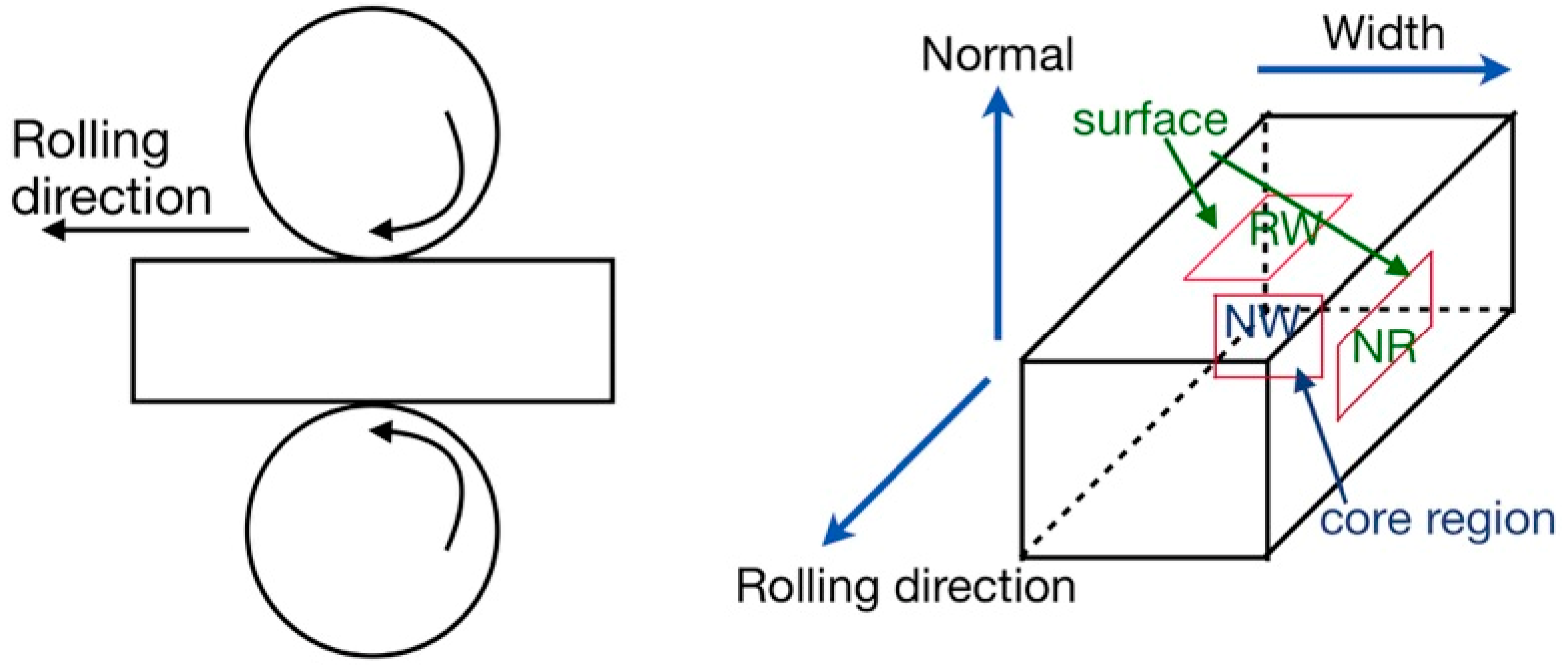

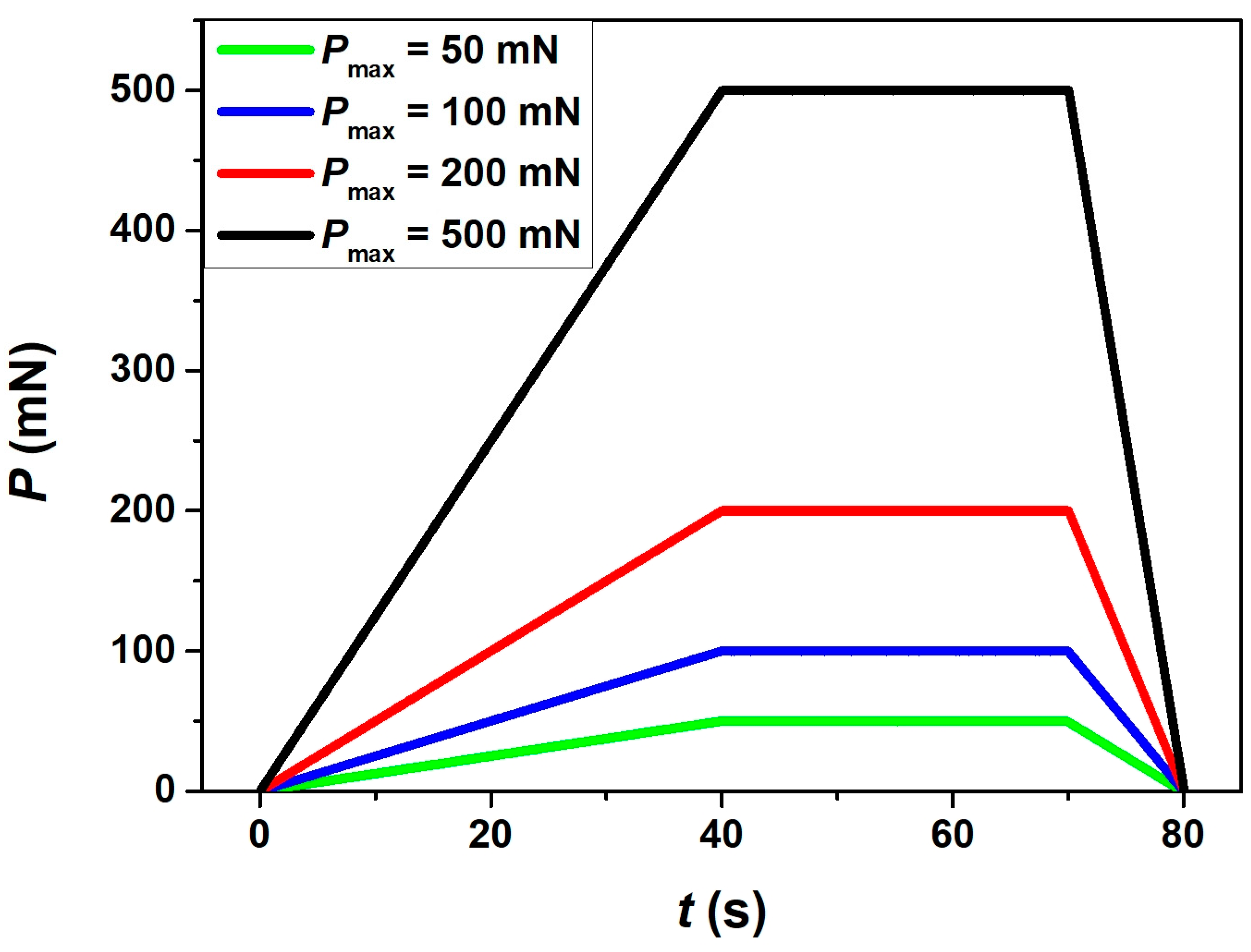
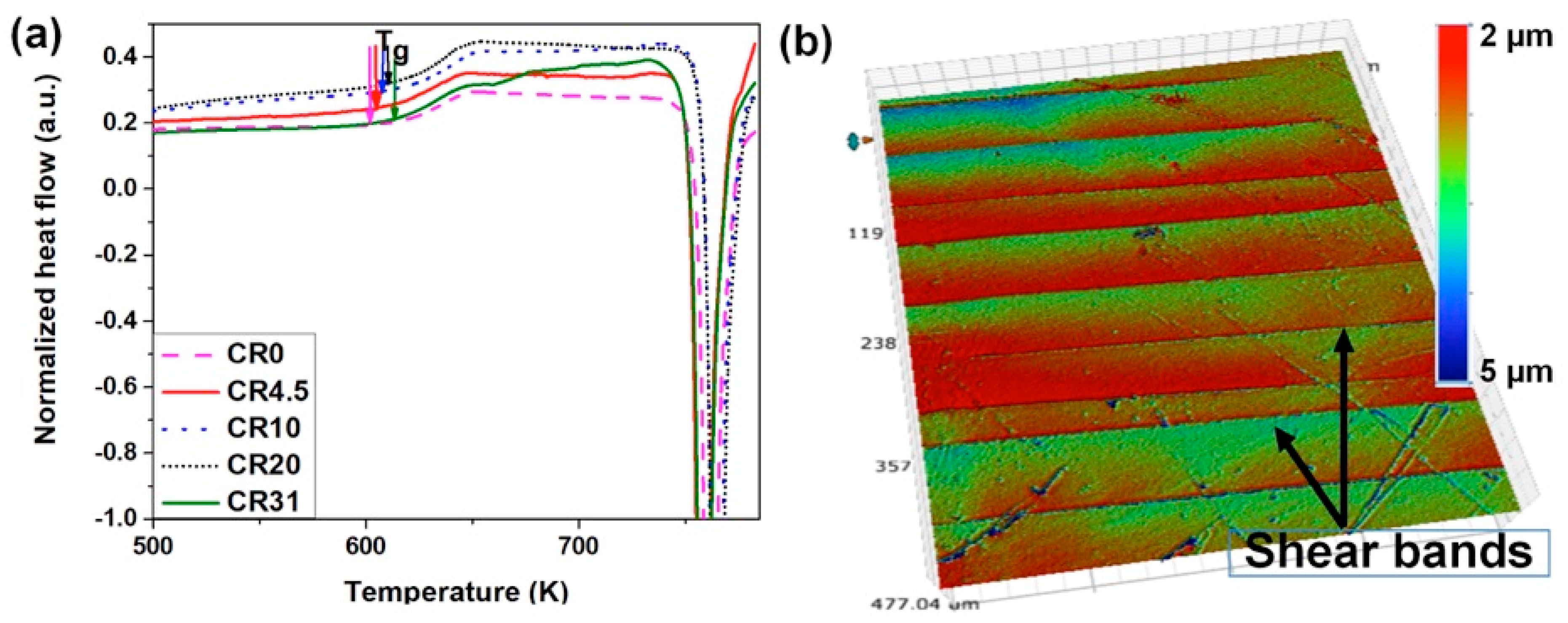

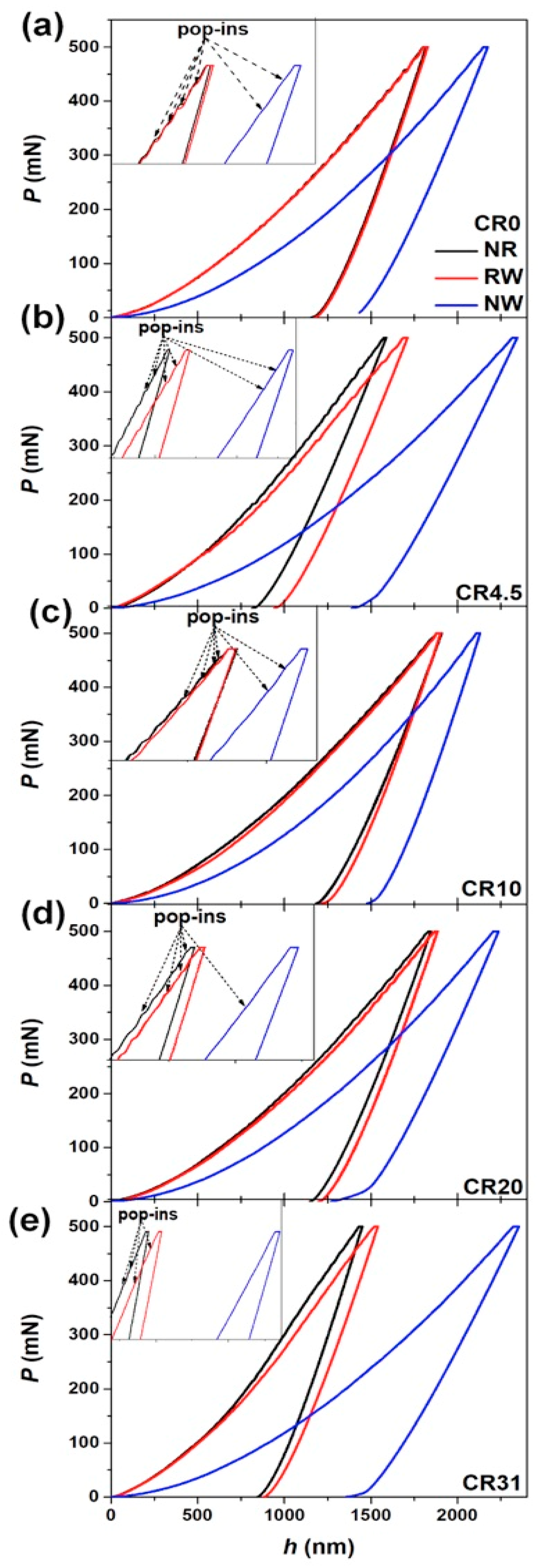
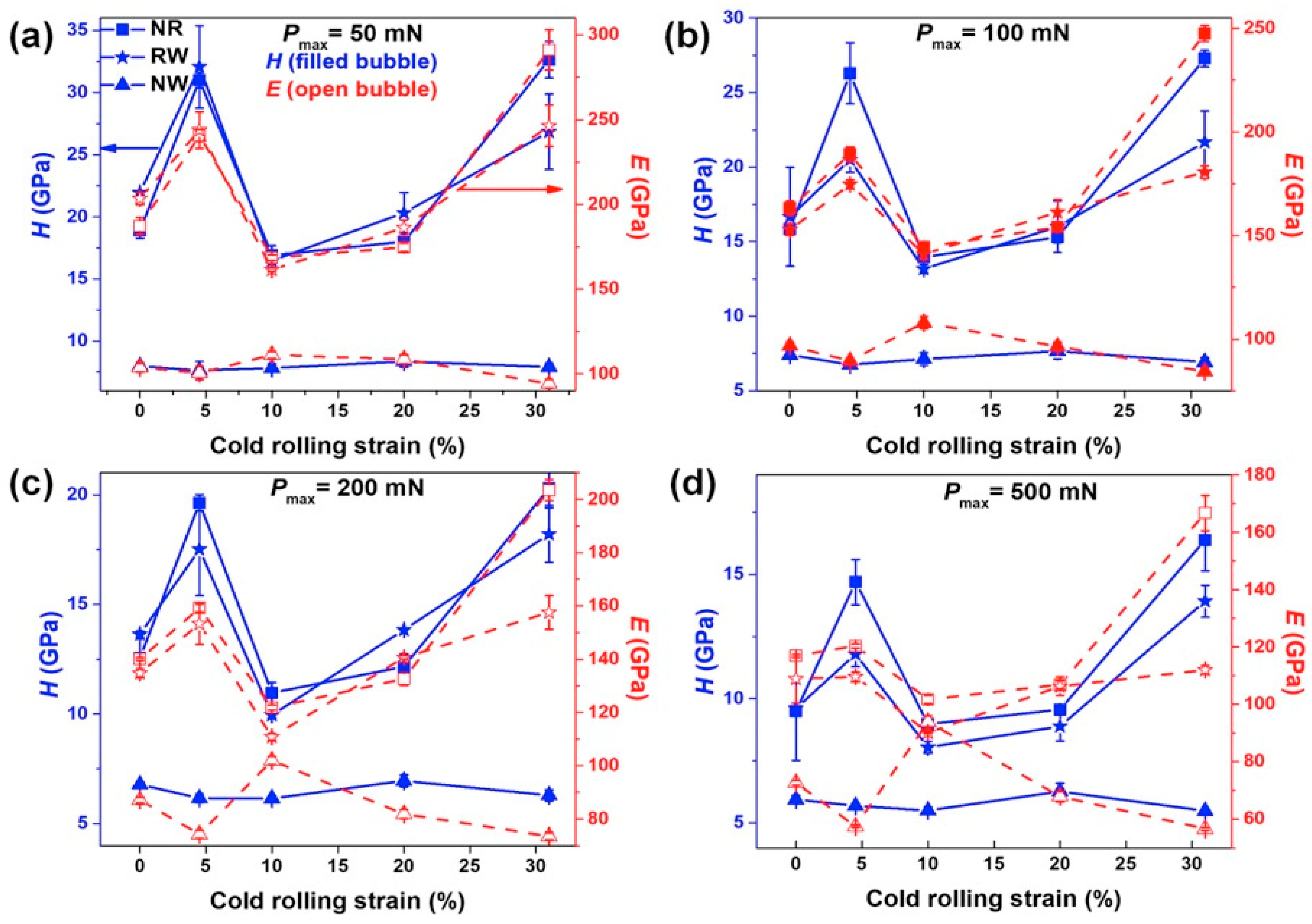

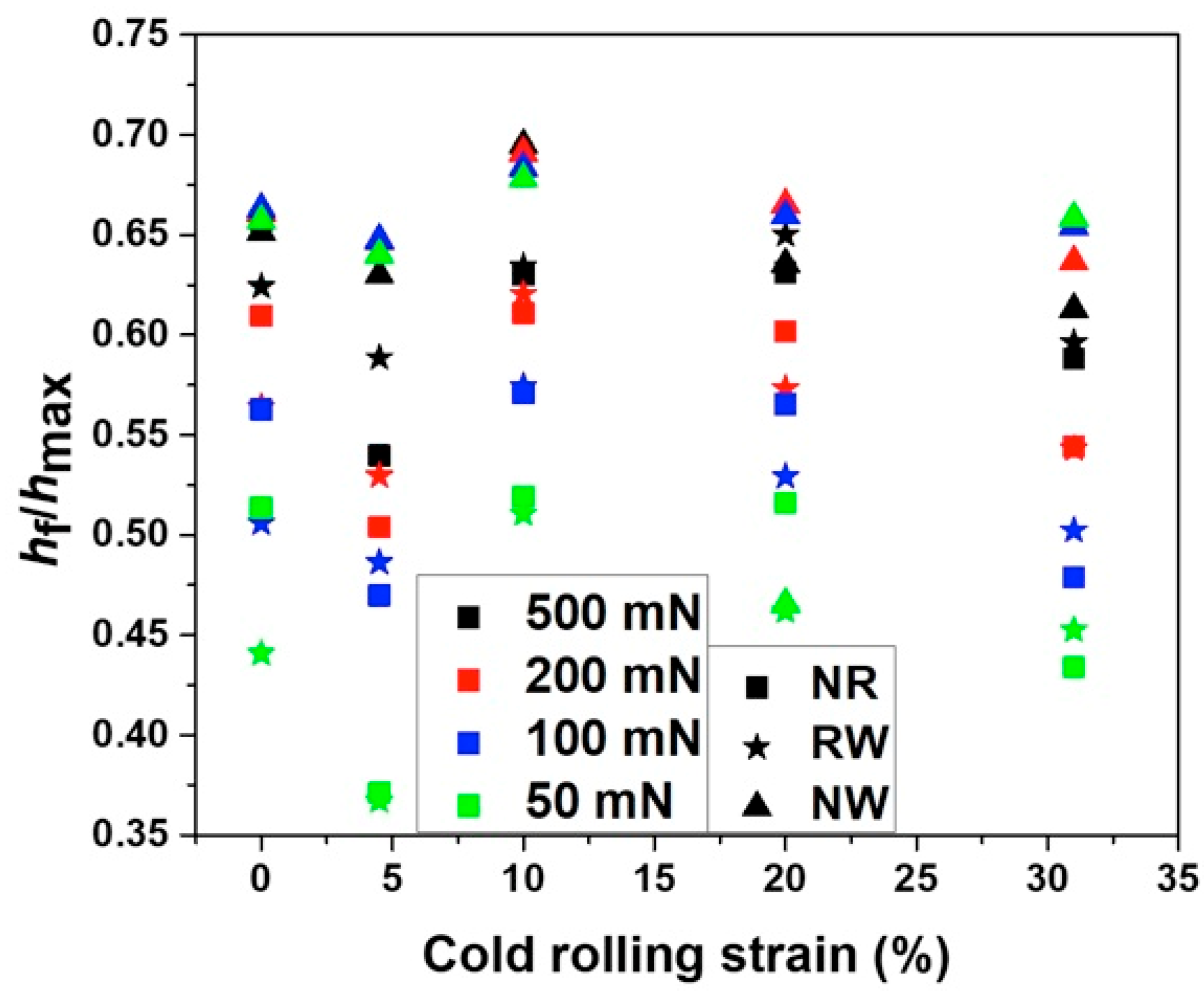

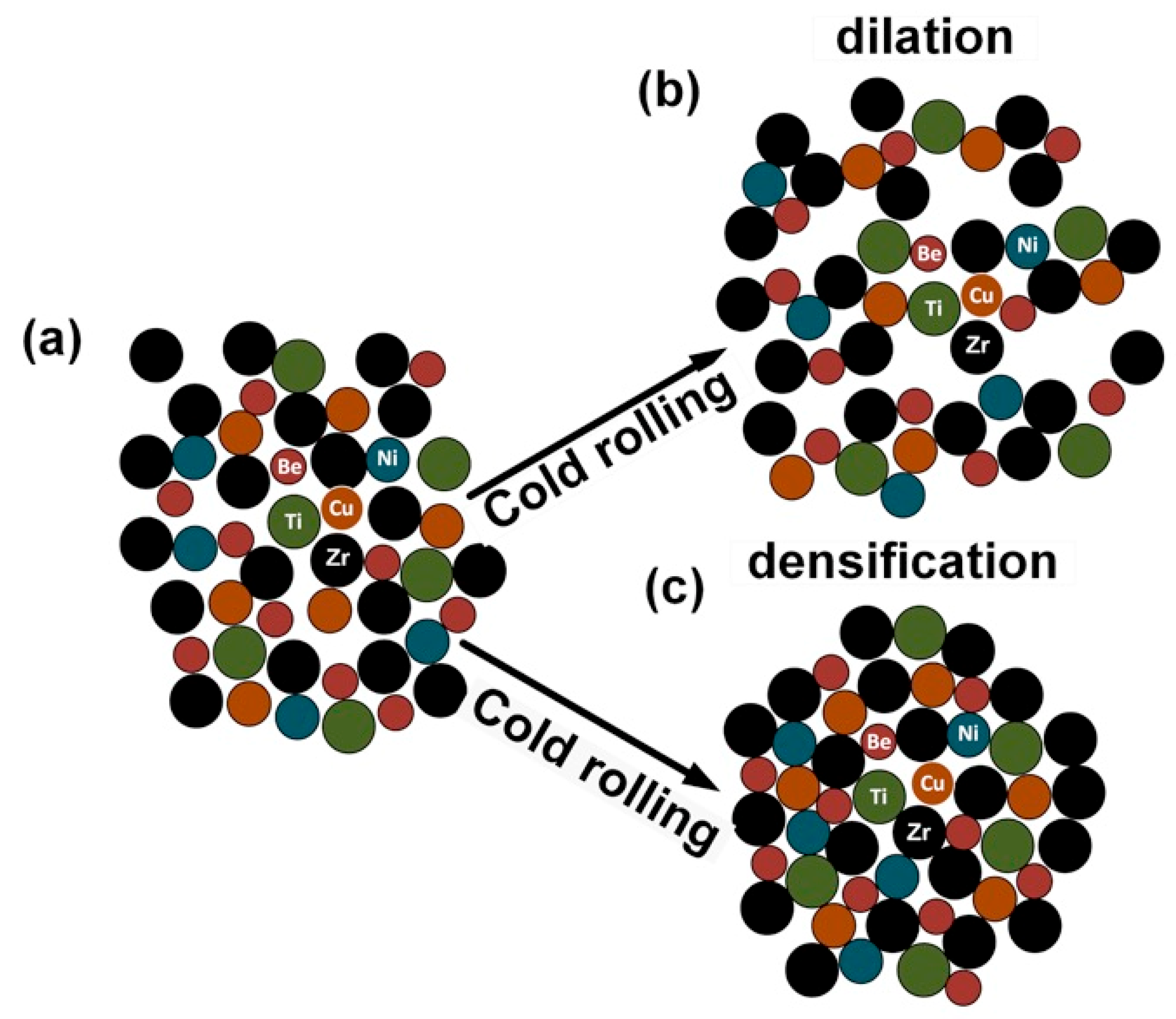
| H (GPa) NR | E (GPa) NR | |||||||
|---|---|---|---|---|---|---|---|---|
| PMax (mN) | 50 mN | 100 mN | 200 mN | 500 mN | 50 mN | 100 mN | 200 mN | 500 mN |
| CR0 | 18.9 ± 0.6 | 15.9 ± 0.1 | 12.6 ± 0.9 | 9.5 ± 0.1 | 187 ± 5 | 163 ± 3 | 140 ± 1 | 117 ± 1 |
| CR4.5 | 31.0 ± 0.6 | 26.3 ± 2.0 | 19.6 ± 0.4 | 14.7 ± 0.9 | 241 ± 4 | 189 ± 4 | 159 ± 2 | 121 ± 1 |
| CR10 | 16.9 ± 0.8 | 13.9 ± 0.5 | 10.9 ± 0.5 | 9.0 ± 0.1 | 169 ± 2 | 144 ± 2 | 122 ± 1 | 102 ± 2 |
| CR20 | 18.0 ± 0.3 | 15.3 ± 0.4 | 12.2 ± 0.6 | 9.5 ± 0.1 | 175 ± 3 | 154 ± 1 | 133 ± 2 | 107 ± 2 |
| CR31 | 32.6 ± 1.6 | 27.3 ± 0.6 | 20.3 ± 0.9 | 16.4 ± 1.2 | 291 ± 12 | 248 ± 4 | 204 ± 4 | 167 ± 6 |
| H (GPa) RW | E (GPa) RW | |||||||
|---|---|---|---|---|---|---|---|---|
| PMax (mN) | 50 mN | 100 mN | 200 mN | 500 mN | 50 mN | 100 mN | 200 mN | 500 mN |
| CR0 | 21.9 ± 0.2 | 16.7 ± 3.3 | 13.8 ± 0.1 | 9.6 ± 2 | 204 ± 4 | 153 ± 3 | 135 ± 1.5 | 109 ± 8 |
| CR4.5 | 32.1 ± 3.3 | 20.5 ± 0.8 | 17.5 ± 2.1 | 11.8 ± 0.5 | 244 ± 11 | 175 ± 2 | 153 ± 8 | 110 ± 2 |
| CR10 | 16.5 ± 0.2 | 13.2 ± 0.3 | 9.9 ± 0.1 | 8.0 ± 0.2 | 161 ± 2 | 141 ± 3 | 111 ± 1 | 90 ± 0.3 |
| CR20 | 20.3 ± 1.6 | 16.0 ± 1.8 | 13.6 ± 0.1 | 8.9 ± 0.6 | 186 ± 5 | 161 ± 6 | 141 ± 1 | 106 ± 3 |
| CR31 | 26.8 ± 3.0 | 21.7 ± 2.1 | 18.2 ± 1.3 | 13.9 ± 0.7 | 246 ± 12 | 181 ± 3 | 158 ± 6 | 112 ± 1 |
| H (GPa) NW | E (GPa) NW | |||||||
|---|---|---|---|---|---|---|---|---|
| PMax (mN) | 50 mN | 100 mN | 200 mN | 500 mN | 50 mN | 100 mN | 200 mN | 500 mN |
| CR0 | 7.9 ± 0.3 | 7.4 ± 0.3 | 6.8 ± 0.1 | 5.9 ± 0.2 | 104 ± 2 | 97 ± 2 | 87 ± 1 | 73 ± 1 |
| CR4.5 | 7.6 ± 0.7 | 6.8 ± 0.1 | 6.2 ± 0.2 | 5.7 ± 0.1 | 100 ± 4 | 90 ± 0.2 | 74 ± 2 | 58 ± 0.4 |
| CR10 | 7.9 ± 0.3 | 7.1 ± 0.4 | 6.2 ± 0.1 | 5.5 ± 0.1 | 111 ± 2 | 108 ± 3 | 102 ± 2 | 94 ± 2 |
| CR20 | 8.4 ± 0.5 | 7.7 ± 0.5 | 6.9 ± 0.3 | 6.3 ± 0.3 | 109 ± 3 | 96 ± 2 | 82 ± 2 | 68 ± 2 |
| CR31 | 7.9 ± 0.3 | 6.9 ± 0.3 | 6.3 ± 0.3 | 5.5 ± 0.1 | 94 ± 3 | 84 ± 2 | 74 ± 1 | 57 ± 0.5 |
| Affected Volume (µm)3 | ||||||||||||
|---|---|---|---|---|---|---|---|---|---|---|---|---|
| NR | RW | NW | ||||||||||
| Pmax (mN) | 50 | 100 | 200 | 500 | 50 | 100 | 200 | 500 | 50 | 100 | 200 | 500 |
| CR0 | 0.63 | 1.03 | 1.83 | 3.63 | 0.53 | 0.93 | 1.73 | 3.33 | 1.23 | 1.83 | 2.63 | 4.33 |
| CR4.5 | 0.43 | 0.83 | 1.33 | 2.63 | 0.43 | 0.83 | 1.43 | 3.13 | 1.23 | 1.73 | 2.63 | 4.43 |
| CR10 | 0.63 | 1.13 | 2.03 | 3.63 | 0.63 | 1.23 | 2.13 | 3.83 | 1.23 | 1.83 | 2.73 | 4.53 |
| CR20 | 0.63 | 1.13 | 1.83 | 3.53 | 0.53 | 1.03 | 1.73 | 3.73 | 1.23 | 1.83 | 2.73 | 4.23 |
| CR31 | 0.43 | 0.73 | 1.33 | 2.63 | 0.43 | 0.83 | 1.43 | 2.83 | 1.33 | 1.83 | 2.63 | 4.33 |
Publisher’s Note: MDPI stays neutral with regard to jurisdictional claims in published maps and institutional affiliations. |
© 2021 by the authors. Licensee MDPI, Basel, Switzerland. This article is an open access article distributed under the terms and conditions of the Creative Commons Attribution (CC BY) license (https://creativecommons.org/licenses/by/4.0/).
Share and Cite
Gunti, A.; Jana, P.P.; Lee, M.-H.; Das, J. Effect of Cold Rolling on the Evolution of Shear Bands and Nanoindentation Hardness in Zr41.2Ti13.8Cu12.5Ni10Be22.5 Bulk Metallic Glass. Nanomaterials 2021, 11, 1670. https://doi.org/10.3390/nano11071670
Gunti A, Jana PP, Lee M-H, Das J. Effect of Cold Rolling on the Evolution of Shear Bands and Nanoindentation Hardness in Zr41.2Ti13.8Cu12.5Ni10Be22.5 Bulk Metallic Glass. Nanomaterials. 2021; 11(7):1670. https://doi.org/10.3390/nano11071670
Chicago/Turabian StyleGunti, Abhilash, Parijat Pallab Jana, Min-Ha Lee, and Jayanta Das. 2021. "Effect of Cold Rolling on the Evolution of Shear Bands and Nanoindentation Hardness in Zr41.2Ti13.8Cu12.5Ni10Be22.5 Bulk Metallic Glass" Nanomaterials 11, no. 7: 1670. https://doi.org/10.3390/nano11071670
APA StyleGunti, A., Jana, P. P., Lee, M.-H., & Das, J. (2021). Effect of Cold Rolling on the Evolution of Shear Bands and Nanoindentation Hardness in Zr41.2Ti13.8Cu12.5Ni10Be22.5 Bulk Metallic Glass. Nanomaterials, 11(7), 1670. https://doi.org/10.3390/nano11071670






